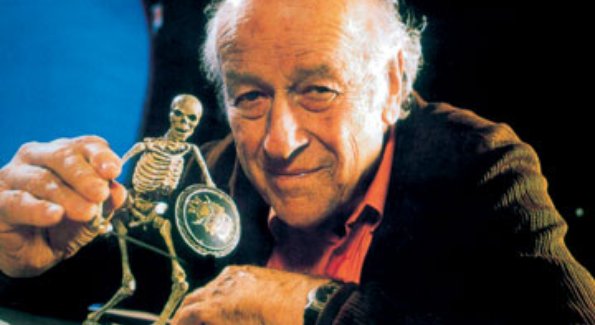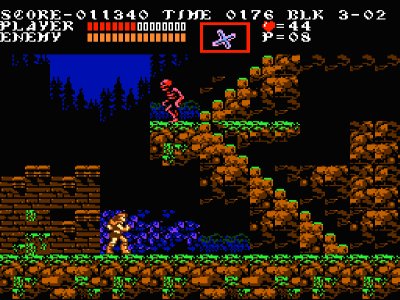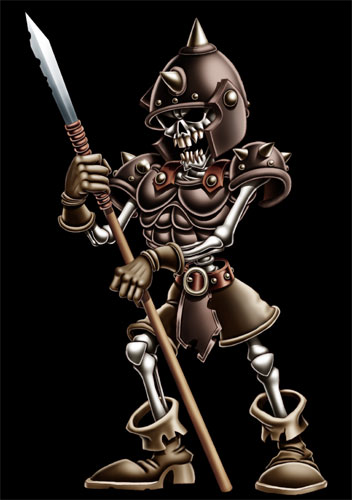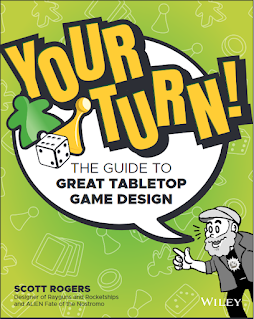I'm playing through my vast game collection one game at a time, one hour at a time.
Ao Oni has no cover, but if it did, this would be a great image
Game: Ao Oni
Developer: noprops
Publisher: NA - freeware
Published in: 2009
Genre: Survival Horror
Rating: Unrated (but I would rate it T)
For the entire weekend, my eleven-year old daughter has been begging me to download a game called Ao Oni - or Blue Demon. She says it's a horror game where you "die a lot." As a fan of horror games, I was intrigued, but I was especially intrigued when I started to do research on the game.
First off, Ao Oni is an RPG Maker mod - not quite what I expected. For those of you who aren't familiar, RPG Maker is a pretty nifty piece of software which allows wanna-be game developers to create their own JRPGs. It has really simple scripting tools and templates for you to create your own sprites and tiled artwork. I was familiar with RPG Maker, especially since after writing my book (Level Up! The Guide to Great Video Game Design - pluggity plug), I get many e-mails from excited children wanting to know what they can do to get into games (I tell them "make games") and from their somewhat anxious parents who want to know if their kids can actually make a living with this "video game stuff." (I tell them "yes.")
The other interesting thing about Ao Oni is that it is ridiculously popular. Not popular on a level that people like you or me understand, but internet popular - the way Homestuck or Charlie the Unicorn or Hark A Vagrant is popular. Trust me, if you aren't under 25 or have kids that are, you'll never find this stuff. There have been a bajillion fan versions of Ao Oni and it's gotten so popular in it's native Japan that they're starting to write novels about it. I suspect an anime cannot be too far off. Get on the train while you still can.
In order to play Ao Oni - it's free btw - you have to download the RPG Maker Run Time Package file exporter and extract a zip file of the game. Once you do that, it's a pretty quick process and soon you're ready to Game Up!
I've seen various amateur/fan created projects over the years but I was moderately shocked at how bare-bones Ao Oni is. There's nothing resembling a start screen except for this:
This is the start screen. Honest
And forget anything resembling a manual. There's not even a control scheme to be found. Don't bother with pressing every key on your keyboard like I did. As a public service to your sanity, here is Ao Oni's control scheme.
ARROW KEYS - moves character
ENTER - Examines objects, collects items, pushes things, opens and closes doors and closets
X or ESC key - Opens inventory
That's pretty much it. And that's pretty much the gameplay.
I should have taken this kid's advice
To sum up my one hour play session, I wandered around the house, collected some items, "solved" a couple of puzzles (more on that in a moment), frequently got chased by the Ao Oni and died or hid in a closet and escaped. The game doesn't mess around and by the end of the hour I felt like I had made somewhat good progress in the game.
Get used to seeing this... a lot
That's the thing about Ao Oni. It's ridiculously simple. The plot is simple - four kids get stuck in house with demon on the loose. The gameplay is simple - explore the house/advance the story without getting caught by the demon. Run if the demon finds you. Hide in a closet without being seen. Solve some puzzles (still more on that in a moment) The art is simple - for a "haunted" house the place is extremely well-lit and there's almost no detail to the art. The dialogue is sparse at best. The whole presentation is almost amateurish (and this is the 6th version of the game - according to the game's fan run Wiki, the game has undergone drastic changes both in story, gameplay and art with each iteration) except for one thing... AO ONI IS SCARY!
I wuv to eat yooo
It's not the titular Blue Demon that's scary. That creature is one of the stupidest looking monsters I've ever seen. He's blue as a Smurf. He has pudgy little arms and legs. He has a ridiculous run cycle. He has big soulful eyes like one of those "I Love You This Much" statues from the 70's.
OMG! He's RIGHT BEHIND YOU!!!!!!
Where Ao Oni is effective is this: The player knows that at any moment, they're going to get scared. They don't know where or when, but they know it's going to happen. It's the context that's scary. The house is barren. You're all alone. You can hear wind blowing outside but not much else. When the Ao Oni appear, he comes out of nowhere and starts to chase you as "scary music" plays that could have come from the keyboard of John Carpenter. And when it happens, the player panics, runs the wrong way or into a way and wham! the Ao Oni gets 'em. Come to think of it, the gameplay is similar to other survival horror games like Clock Tower, Resident Evil Nemesis or Amnesia.
Here's an important Pro-Tip. See that "Save" command? You're going to need it. A LOT. Not since the original Doom have I saved a game so often. And not since the end of Dead Space 2 have I died so much in a survival horror game. As long as the Oni isn't in the room chasing you, save your game.
OOOOH NOESSSS!!!! NOT ANOTHER ONE!!!!!!!
There is one other mechanic that Ao Oni does well - when the player hides in a closet, if they haven't evaded the Oni for a predetermined amount of time or the Oni sees you go into the closet, he will peek in and find you. The presentation is startlingly effective and I jumped the first time it happened to me.
This is Ao Oni's first puzzle. Have you solved it yet?
So far, this might sound like Ao Oni is a good game. Now let's talk about the puzzles. There's no mechanism that lets the player know they've found an item. There's no "observe" so the player can tell what they're looking at. I hate to do this, but I had to go online to find the solution to the first puzzle. The first item that you find doesn't even come into play until close to an hour into the game. The lack of information really hampers the experience. With some simple instructions and dialogue boxes, this could all be avoided.
Ah the infamous toilet. My kids were very amused to see a toilet in a video game
My other problem with Ao Oni is that it cheats. The player is unjustly and randomly killed off at almost anytime. (I understand that there's a 10 percent chance that if the player enters a room the Oni will swoop in and kill them) The best/worst example of this was at the beginning of the game. There is a door that, as you pass, a shadow moves past it. Having seen this happen before in games such as F.E.A.R. and Resident Evil 2, I went to investigate. My character opened the door, went into the room (without the camera following - as was the case in the previous rooms) and the next thing I know, a splatter of blood sprays against the glass and the words "Game Over" come up. What the hell? Since when is that fair? Well, it might not be fair, but it did make me edgy, which did ratchet up the fear factor... and like I said, Ao Oni does provide the scares.
Get used to seeing this
So, should I keep exploring the house of Ao Oni or stick it back in the closet?
What would I do differently? So many things. The art could be greatly improved to add to the atmosphere. A starting screen would make the game look more professional. I couldn't figure out how to backspace to change my character's name. I would provide a tutorial for movement or at least a control screen. I would have dialogue boxes pop up for when the player examines items in a room or finds an inventory item. I could go on and on...
Will I keep playing? Sadly no. I'll leave that up to my kids. I think I've seen all that Ao Oni has to offer. While it is creepy, I'd rather spend my time playing Fatal Frame or Haunting Ground. However, I can honestly say that I feel a little more "in the know" for playing it.


























































